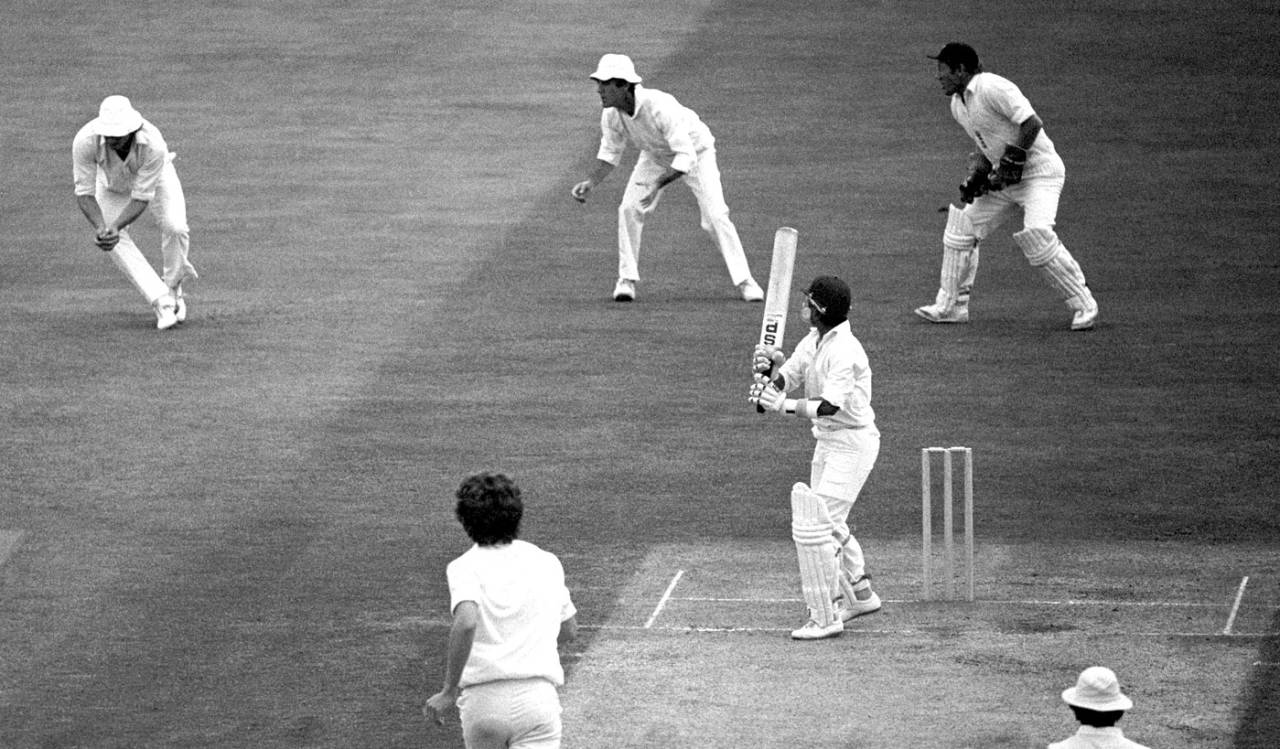When you're a young cricketer of very limited ability but unlimited passion, finding role models can be difficult. It seemed a bit ludicrous to pretend I was channelling Sunny Gavaskar or Mansur Ali Khan Pataudi in my batting when I could barely get bat on ball let alone send it scudding to the fence with a flick of my wrists. Rather befittingly then, I developed an attachment to a couple of batsmen who seemed to epitomise the triumph of determination over talent, or of grit and gumption over grace, if you will:
Chetan Chauhan and
Yashpal Sharma.
These were guys who never gave their wicket away with a fancy hook or an airy waft. Each run was eked out in painstaking fashion, and regrettably, even at the end of a sizeable knock from them, you would be hard put to remember a single stroke. They were the precise opposite of blithe spirits like David Gower or VVS Laxman, the guys who made it all look so easy and effortless. And yet, as I will soon show, this initial impression of mine that Chauhan and Yashpal were only capable of playing stodgy cricket was just plain wrong.
When Chauhan began his Test career, he was soon described as a strokeless wonder.
On debut against New Zealand in 1969, despite rather startlingly hitting a six in his brief first innings, in the second innings Chauhan pottered for 34 runs in 200 minutes with no boundaries. He was similarly glacial in the next couple of Tests he played that season and was duly dropped.
It was never the case that Chauhan couldn't play attacking cricket. It was just that he kept the big shots away in the interest of minimising risk, and he did it for the team
When I watched Chauhan against Tony Lewis' MCC
at Chepauk on his comeback to the Test team in 1973, after getting out for a duck in the first innings, he crawled to 11 runs off 52 balls in the second. A painful 22 (in almost three hours with one boundary) in the first innings and one run off 24 balls in the second innings
on a Kanpur feather bed in the next Test meant Chauhan was dropped for good - or so it seemed.
Unlike India's selectors (and the vast majority of fans), I had developed a soft corner for Chauhan's struggles out in the middle. There was something noble about his refusal to throw his wicket away despite his inability to get the ball off the square. He seemed in a world of his own and his agonies seemed similar to mine - only on a larger, much larger, scale.
Of course Chauhan made yet another comeback, when he was selected to tour Australia in 1977-78, and this time around things clicked for him. He went on to establish himself as a successful Test opener in partnership with Gavaskar.
I was eyewitness to a different Chauhan altogether when I next saw him at Chepauk, this time against Asif Iqbal's Pakistan,
in the Pongal Test of 1980, when India were set 76 to win on the final day. They not only got there at a rollicking rate of 4.33 runs per over, Chauhan blazed his way to an unbeaten 46 with eight boundaries - most of them rasping square cuts and flashing back-foot cover drives off Imran Khan and Sikandar Bakht.
It was never the case that Chauhan couldn't play attacking cricket. It was just that he kept the big shots away in the interest of minimising risk and for the sake of the team. That six he hit in his very first Test innings would also be the last one he hit despite playing another 39 Tests.
Yashpal played 37 Test matches in India's middle order over the late-1970s and early-1980s, and ended with a respectable career average of 33.45. With a stocky physique that seemed hewn out of solid wood, and a very limited range of shots, Yashpal would wait patienly for a rank bad ball to dispatch to the fence. Otherwise his main scoring shots seemed to be the nudge, nurdle, edge, bunt, and the push. Fortunate to have played a good chunk of his Tests at home (only two of his
11 scores higher than 50 were outside the subcontinent), Yashpal clearly lacked the ability to collar good bowling or master unfamiliar conditions.
Yet, for Indians of my generation, he would come to be epitomised by a single shot of breath-taking beauty. It was not in a Test match but in the
semi-final against England in the historic 1983 World Cup, which India ended up winning.
Today's fans might find it hard to believe that the target of 214 that England set for India in 60 overs was not seen as a cakewalk at the time. As Mohinder Amarnath and Yashpal ground their way slowly towards it (and an undreamt of place in the finals), the tension was palpable.
Every now and then a boundary would relieve the pressure, but well into the middle overs, as an India fan, you were still wondering if the batsmen would hold their nerve, and were bracing yourself for the inevitable collapse.
It was around then that Bob Willis bowled what seemed to be a very fast yorker headed straight for Yashpal's leg stump. Yashpal swivelled gracefully and deposited the ball high over square leg for a six with nothing more than a waft of his bat. It was pure timing and all he had done was use Willis' pace against him. In my mind, with that one stroke Yashpal erased all those painful hours of dour accumulation and unmemorable strokes that had characterised much of his career.
Chauhan and Yashpal were clearly playing within their limitations for much of their careers. Yet these vignettes showed what they were capable of doing when the conditions were right, and gave us a glimpse of the talent that lay within their otherwise stolid personas.

